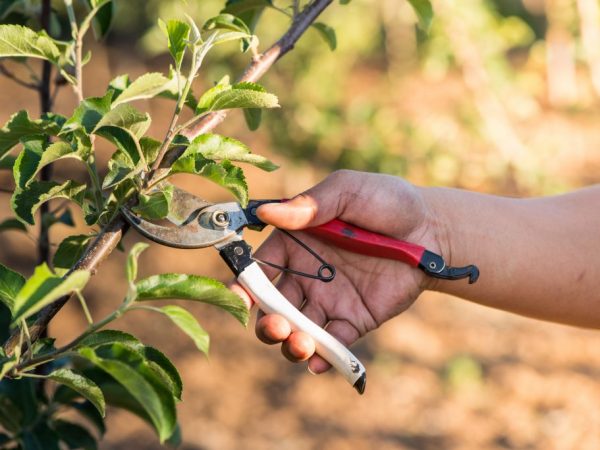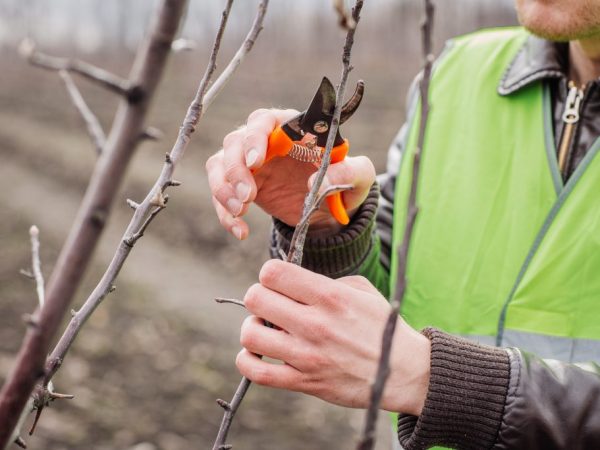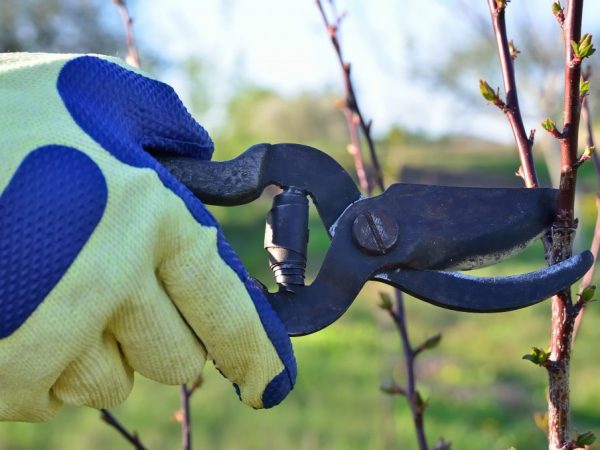Rules for pruning columnar apple trees
In comparison with classical apple trees, which reach a height of about 6-8 m and have a crown with a diameter of about 10 m, varieties growing in columns can significantly reduce the garden area due to the peculiarities of growth. Regular pruning of columnar apple trees allows you to ensure the correct development of the fruit crop and get a decent harvest.

Rules for pruning columnar apple trees
Why do you need pruning
Columnar trees are rather compact, low, which makes it possible to grow them in a small area, while several species can be planted at once.
The superficial location of the root system requires regular pruning of the crown, which prevents the appearance and development of fungal, viral and bacterial diseases.
The most important vegetative organ is the apical kidney, when deformed or removed, the lateral processes develop faster. In this case, cropping is necessary because the procedure affects the regularity of fruiting and the quality of the crop.
In addition, you need to trim the columnar apple tree so that:
- strengthen young branches;
- to rejuvenate an adult tree both in the area of individual shoots and everything in general;
- increase productivity;
- prevent branches from tangling and their subsequent breaking off;
- improve the appearance of the tree.
Time to trim
Pruning in the fall is carried out for early summer columnar apple trees. Closer to winter or with the onset of spring, it is recommended to cut off mid- and late-ripening varieties.
Pruning times for different locations:
- in the northern regions of Russia, the procedure is planned for early spring;
- in mid-latitudes and other areas with a warm climate, it is recommended to prune in May or at the very beginning of June, after the end of the flowering stage;
- in any region, throughout the summer, an additional procedure is permissible, which reduces the amount of green mass in trees;
- pruning in the fall is mandatory, sanitary and begins after harvest.
The better to trim
Cut off the branches with a sharp, well-sharpened garden tool. Pinch off individual sprouts with pruning shears.
After the procedure, the resulting wounds are treated with antiseptic solutions to accelerate healing. To create an obstacle to infection, the sections are covered with garden pitch.
How to properly prune an apple tree
The pruning scheme for columnar apple trees differs by season.
In winter
The formation of a horticultural culture in winter involves the removal of special attention to fruiting zones.
The procedure is carried out, gradually shifting from the lower tier of the branches to the upper one. Removing weak, broken and dry branches allows you to reduce the load during the coming winter and with subsequent fruiting.
If there is an apical bud that has frozen over the winter, then the main shoot is selected from the set of replacement shoots. The choice is made in favor of vertically growing, the rest are cut off at the base.
In the spring

In the spring, it is necessary to cut off the frostbitten ends of the branches.
To properly cut a columnar apple tree in the spring, you need to have time to do this before the start of sap flow.
The main purpose of the spring procedure is to stimulate growth. Pinching is more often used, due to which the same number of young shoots are obtained from 4-5 buds left on the cut branch.
At the same time, during spring care, the ends of the branches damaged by frost are removed, which contributes to the rejuvenation and health of the tree.
In summer
Summer pruning of columnar apple trees involves removing unnecessary green shoots that have appeared in the current season.
Shoots grow directly from the center conductor. Remove them by plucking. They look at young shoots that originate directly from the central trunk, and those that simply develop into a green mass are removed.
In autumn
In autumn, the movement of plant sap is suspended, which makes it possible to remove unnecessary branches - old, crossed among themselves, having received mechanical damage and showing signs of pests and diseases.
This is done for sanitary purposes. Autumn care allows you to reduce the load on the garden culture in winter under a layer of snow.
Also in this season, the green growth that has appeared in the summer, growing from the central conductor, is removed.
Pruning scheme for a good harvest
The basic scheme for pruning columnar trees is based on the growth of horticultural crops:
- the vertical direction of growth of the branch gives it the greatest intensity of elongation per season;
- horizontally, the branches grow noticeably more slowly, showing minimal elongation, but more flower buds are formed on them.
Therefore, when caring for a tree, it is worth removing mainly annual vertical shoots that act as an obstacle to the development of branches. They pull off nutrients and reduce the number of ovaries.
The pruning technology involves the distribution of stages over several years:
- in the first year after planting the seedling in a permanent place, all lateral branches are shortened to the location of only two living buds located closer to the trunk;
- in the second year of life, one strong branch will develop from the left buds - the one that began to grow in the vertical direction is cut off again, leaving two buds, and the one that grows horizontally is left as a future fruit;
- in the third year, the horizontal branch, which has borne fruit, is completely removed, and from the remaining, the future fruiting branch is again selected, repeating the pruning operation in the 4th year;
- in the fifth year, the entire fruit bud is cut into a ring, and the processes that have grown from the trunk over the years are cut off in a similar way.
How to avoid mistakes

It is important to cut the shoots correctly
The mistakes made by novice gardeners in the process of pruning an apple tree lead to the fact that the pruned branches stop growing, do not bear fruit and dry out.
Common errors:
- strong shortening, which leads to the death of the branch;
- excessively oblique cut, leading to injury to the tree bark;
- too close pruning in relation to the place of growth of the kidney, which interferes with its subsequent development.
The healthy growth of a pruned tree and a rich harvest from it is facilitated by:
- correct execution of the cut in the direction from the base to the apex, opposite from the extreme kidney;
- the location of the cut at a distance of more than 1.5 cm above the place of growth of the kidney;
- making an even cut, without scuffing the tree bark.
These tips allow you to care for your garden crop without damaging it.
Correct pruning of columnar apple varieties allows for the full development of horticultural crops and high yields.
The stages of the formation of apple tree growth are distributed over several years and are carried out according to the generally accepted scheme.

